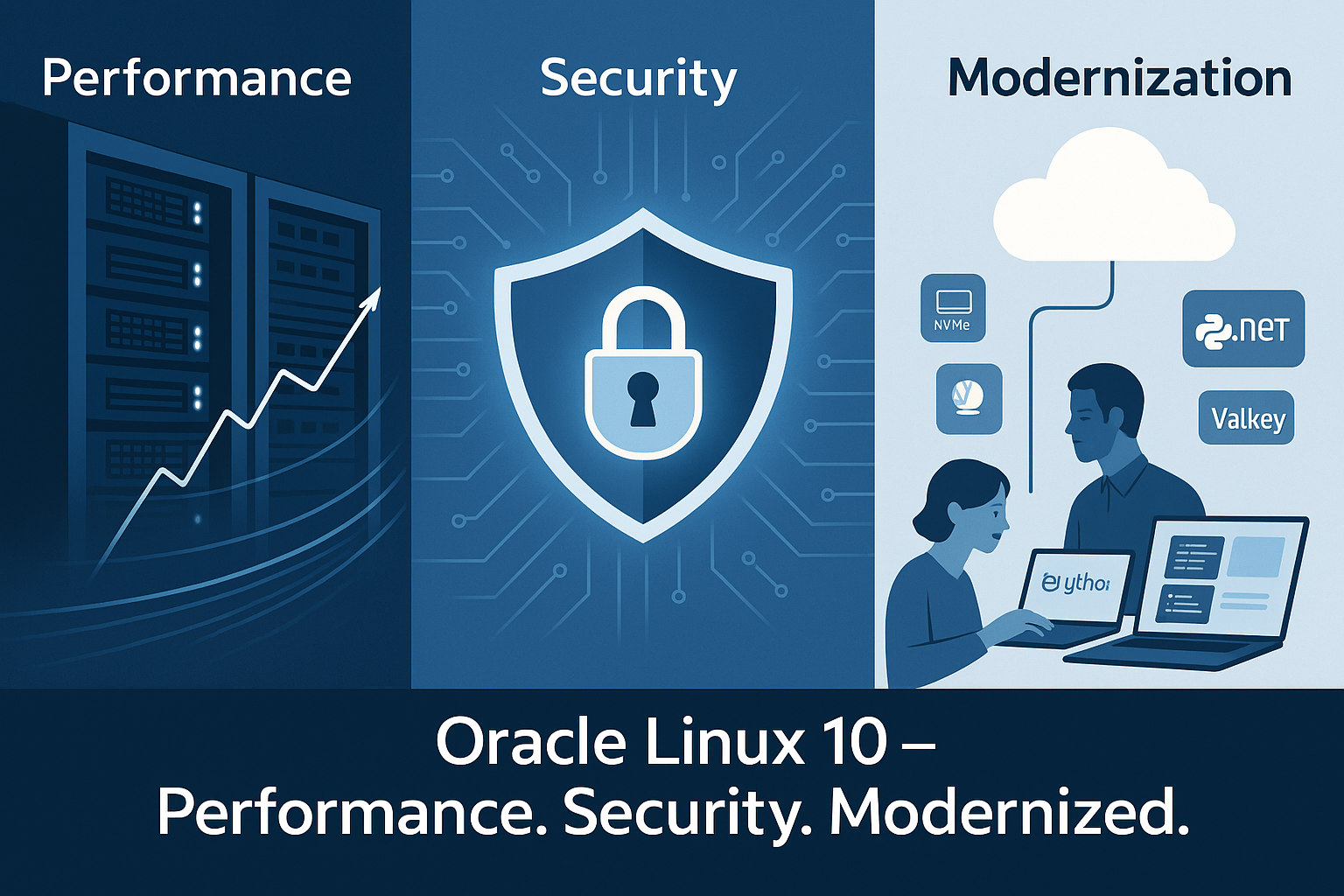Oracle Linux 10 is Here: What You Need to Know
Oracle has officially released Oracle Linux 10 (OL10), marking a significant step forward for enterprise Linux environments. Built as the downstream release of RHEL 10, OL10 is now generally available for x86_64 (x86-64-v3) and ARM aarch64 architectures. On ARM, the Unbreakable Enterprise Kernel (UEK) is the only supported option, while x86 continues to support both UEK and RHCK.
Whether you’re running Oracle Database, PeopleSoft, or cloud‑native applications, this release brings performance boosts, modern security, and a cleaner, more streamlined experience for administrators.
Here’s what stands out.
🚀 Performance and Kernel Options
By default, Oracle Linux 10 installs with UEK 8.1, which is based on Linux 6.12 LTS with selected 6.15 backports for improved hardware and storage performance.
This kernel delivers:
- Better NUMA memory handling and I/O scheduling
- Improved SSD and NVMe performance
- ABI changes that require rebuilding third‑party kernel modules
If your workloads rely on close RHEL compatibility, the Red Hat Compatible Kernel (RHCK) remains available for x86_64 systems, but UEK is the path to the highest performance, especially for Oracle database or middleware workloads.
🛡️ Security and Live Patching
Enterprise security is a central focus in OL10:
- Oracle Ksplice continues to allow zero‑downtime kernel and user‑space patching, covering components like OpenSSL and glibc.
- Post‑Quantum Cryptography (PQC) support arrives in OpenSSL as a technical preview, preparing for future cryptographic standards.
- OpenSSH has new mitigations for side‑channel and credential theft attacks, ensuring safer remote access in modern hybrid environments.
For admins who value uptime, the Ksplice enhancements alone make OL10 a compelling upgrade.
👩💻 Modern Developer and Admin Tools
Oracle Linux 10 updates the toolchain for both developers and sysadmins:
- GCC with enhanced diagnostics, modern OpenMP, and stronger security flags
- Valkey (a Redis-compatible in‑memory store) is now included
- .NET 9.0 (new features) and .NET 8.0 LTS for stable enterprise apps
- Python 3.12, OpenJDK 21, and CMake 3.30
- Updated diagnostic tools like SOS with namespace‑standard plugins and new flags
These updates make OL10 friendlier for building, testing, and running modern workloads across cloud and on‑prem environments.
⚙️ Installer and Infrastructure Improvements
The OL10 installer simplifies setup and supports modern infrastructure out of the box:
- Auto‑creation of a sudo‑enabled admin user for faster deployments
- Native NVMe‑over‑Fabrics support during installation
- GRUB 2.12 with better firmware memory allocation, VLAN and UART support, and TPM fixes
These enhancements make provisioning in cloud and virtualized environments faster and more predictable.
🧹 Cleaning Up: Deprecations and Removals
Oracle Linux 10 also continues the move toward a modernized, leaner OS:
- Deprecated: cgroup‑v1, legacy ipset, podman plugins, libvirtd
- Removed: cockpit‑composer, SquashFS, runc as default
- OpenSSL: ENGINE API and SHA‑1 HMAC in FIPS mode are now deprecated
For sysadmins, this means planning for containerization changes and modern cryptographic policies.
📈 Why This Release Matters
Oracle Linux 10 is not just a version bump. It’s a modern, performance‑tuned, secure platform for enterprises looking to run critical workloads both on‑premises and in the cloud. With Ksplice, UEK 8.1, and updated toolchains, it positions Oracle Linux as a future‑ready OS for databases, middleware, and cloud‑native apps.
If you’re already on OL9, start testing Leapp for in-place upgrades and validate your third-party modules for UEK 8.1 compatibility.
Your Turn: Are you planning to upgrade to Oracle Linux 10 right away, or will you wait for the first minor update? Drop a comment and share how OL10 might fit into your environment!
